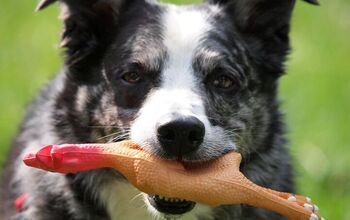Nail Clipping Versus Grinding – Which is Best and How Do You Choose?

If you’re like many pet owners, you probably assume that regular daily walks are sufficient to help wear your pet’s nails down to a naturally ideal length. But you’d be wrong. While walking on hard surfaces does help, it’s not enough to maintain a healthy length.
In fact, your dog’s nails should be trimmed every three to four weeks. Not only because it looks better and you eliminate that annoying clickety-clack every time he scampers across the floor, but because those overgrown, talon-shaped nails can become uncomfortable to walk on and lead to health issues down the line. The repetitive pressure put on your dog’s foot every time that too-long nail hits the ground can actually injure tendons over time and cause his feet to deform and splay. So, let’s talk about how best to complete mani-pedis on a reluctant pooch.
And we’ll start with the tools.
For those who feel ready to complete this task at home, you’ll need to know about the quick. It’s a nerve that extends from the root of the nail to the tip and yes, it hurts if you nick it. The upside is that the quick recedes with the length of the nail and that means that over time it will shorten and you can clip his nails without worry that you’re causing your pet pain (or bleeding).
When it comes to which tool to use, there are a few options. For smaller dogs with tiny nails, a standard toe-nail clipper may be sufficient. Just make sure you’re able to cut in a clean, single stroke for a non-ragged edge. Remember, your pup likes to scratch his ears and face from time to time and jagged tips can cause injury.
For any larger breed, you’re going to want to invest in a quality set of nail clippers. Designed specifically for the task at hand, they deliver quick, precise results. And let’s face it, when you’re dealing with an uncooperative pooch, that’s exactly what you want. They come in a few different designs including a “guillotine” style of clipper that requires you simply insert the tip of your pet’s nail and squeeze the handle for a single clean cut. Then there’s the scissor-style clipper that works just like the name implies. It’s better suited to large breeds with large, thick nails that require a little extra force.
And then there are grinders. Consider this gadget to be both a finishing tool that can be used after clipping to eliminate any ragged edges as well as a maintenance tool that can be used every 7 to ten days to maintain the shorter length. It comes in both a cordless design that works off batteries or can be charged, as well as an electric model that plugs into any standard outlet.
So, between nail clippers and grinders, which tool is best? Let’s take a look at the advantages (and disadvantages) of both.
Related: Best Dog Nail Clippers
Nail Clippers
- Quick – Unlike grinders, clippers don’t require charging, plugging in, or batteries. This makes them easy to use anywhere and anytime a quick nail trim is required.
- Precise – Specifically designed for the shape and thickness of a dog’s nail, both guillotine and scissor-style clippers are fast, accurate, and dust/smell-free.
- Quiet – Particularly for dogs that are easily spooked and anxious around noise, nail clippers are quiet, easy to use and work without vibration.
- One-Cut – Quality nail clippers allow you to make nice clean cuts in single snips. No need to revisit incomplete cuts, no ragged edges and no prolonging the process.
- Strong – Today’s nail clipper is designed to tackle large, thick dog nails quickly and easily.
The downside of nail clippers is that for any dog that has a black or dark colored nail, you’re guesstimating as to where the quick ends. It may take some practice to get it right and, in the meantime, painful clips can mean Rover is going to struggle and become highly reluctant to engage in this grooming exercise again.
Related: Best Dog Nail Grinders
Nail Grinders
- Smooth – Grinders are great for cleaning up the rough edges that can be left after your dog’s nails have been clipped.
- Maintenance – Once your pet’s nails have been cut, it’s easy for you to maintain that optimal length by simply grinding them back every 7 to 10 days.
- Safer – Because it’s a more gradual process, grinding your dog’s nails means it’s easier to gauge how close you’re getting to the quick. So, you can stop sooner and prevent painful nicks.
- Clean-Ups – Active dogs are prone to developing ragged nail edges that can result in inadvertent injury or infection when they scratch themselves. A quick clean-up eliminates this danger.
- Gentle – Not all dogs appreciate having their feet touched, so any style of nail trimming will be met with dread. But with grinding, the slower, less abrupt process can offer an opportunity to interact with your pet, provide soothing words and even offer treats.
While the ease and convenience of today’s cordless nail grinders may imply it’s the perfect alternative to clipping, the challenge for your pet is the noise, dust, and vibrating sensation each time you begin the grinding process. And this tool also requires practice, because the rotating sander can heat up, snag fur and connect with tender pads.
Conclusion
My two rescue pooches had nails that would rival a bald eagle. Seriously, they were talons, not nails and it’s taken a couple of years to get them down to an appropriate length. Apparently, this is common with rescue dogs because, quite frankly, nails seem to take a backseat to other, more obvious health issues. For me, groomers who were too aggressive had my gals anxious and piddling on the floor when we returned for future grooming. Others chose not to deal with my anxious dogs and left their uber-long nails intact – which exacerbated the nail trim situation. For now, we’ve reached a happy solution which is to have them clipped during grooming and ground every two weeks in between. If you’re still sitting on the proverbial fence about whether your pet’s nails need clipping, grinding, both or neither, consider the health risks and the discomfort it causes your pet when overly long nails compromise his enjoyment of his daily walks. A quick rule of thumb is that nails should not quite touch the floor when your dog is in a seated position. But if you can hear your dog walking toward you from 50 paces, it’s time to tackle those nails.

Sharing space with three seriously judgy Schnoodles and a feline who prefers to be left alone. #LivingMyBestLife
More by Mary Simpson






















